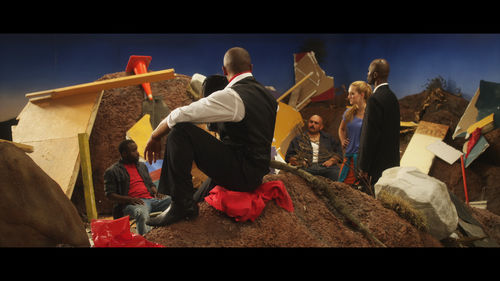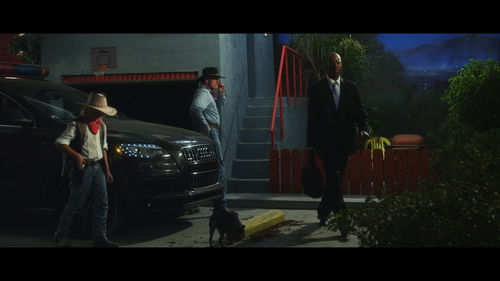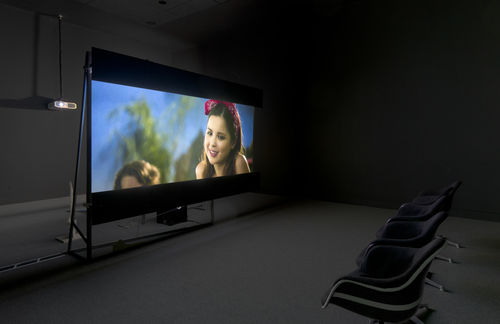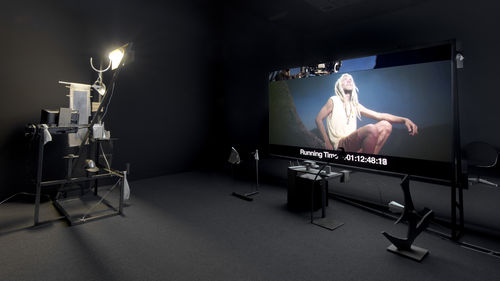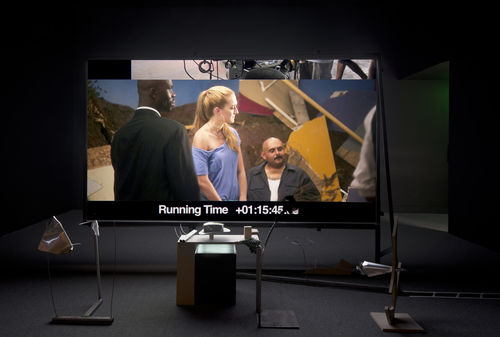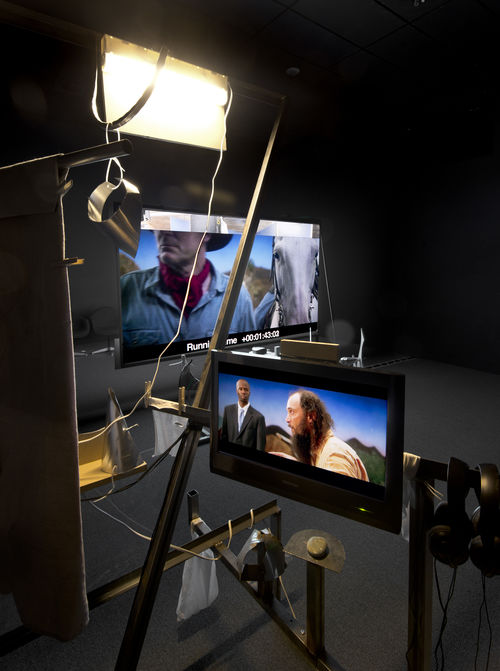
Hammer Projects: Neil Beloufa
- – This is a past exhibition
Hammer Projects: Neil Beloufa is organized by Ali Subotnick, Hammer curator.

Biography
The French artist Neïl Beloufa was born in 1985 in Paris. He studied at the École Nationale Supérieure des Beaux-Arts, Paris; the École Nationale Supérieure des Arts Décoratifs, Paris; California Institute of the Arts, Valencia; Cooper Union, New York; and Le Fresnoy–Studio National des Arts Contemporain, Tourcoing, France. His work has been shown in contemporary art venues as well as in film festivals. He has had solo exhibitions at the Kunstraum Innsbruck, Innsbruck, Austria (2012); the Kunsthaus Glarus, Glarus, Switzerland (2012); the Palais de Tokyo, Paris (2012); the New Museum, New York (2011); and White Box, New York (2008), among others, and has participated in numerous group exhibitions. His videos have been screened at the Toronto International Film Festival (2011); the International Film Festival Rotterdam, Rotterdam, the Netherlands (2009, 2012); and the London Film Festival (2009, 2010, 2011), and he was awarded grand prizes at the 54th and 57th Oberhausen Kurzfilmtage in Oberhausen, Germany. Beloufa has received many other honors, most recently the Audi Talent Award, Paris (2011).
Essay
By Emily Gonzalez
Neïl Beloufa’s work occupies a space between truth and fiction. He shows his videos at film festivals as well as art galleries. He works with untrained volunteers and aspiring actors. The artist situates himself between all these polarities easily because he does not differentiate one from the other. Everything is presented with a flat sincerity, but there is always a touch of humor and irony that makes the work compelling. After watching one of his videos, viewers may find themselves pondering what they have just witnessed, parsing the story line for hints of meaning, and it is in this blurring of boundaries that Beloufa’s work is most engaging.
Beloufa begins many of his projects by putting out an open call for volunteers willing to talk about his theme, and then he prompts his subjects to explain their ideas before a camera in the setting of his choice. Kempinski (2007) was shot in Bamako, Mali, where he recruited locals to describe their thoughts about the future. Filming at night in open fields, in bushes, and on patios, the artist asked the participants to talk about their ideas using the present tense. With only a neon light or two to illuminate the area, the isolation is palpable, and it seems as if the participants are living in a postapocalyptic world. Beloufa overlaid the audio with tonal sounds and inserted images of a tall watchtower beaming light into the night sky between scenes, underscoring the dystopian science-fiction quality of the film. It is small gestures like these that transform a discussion into an abstract or loose narrative.
Other subtleties of framing include the way in which Beloufa constructs the settings for his films. In his untitled film of 2010, he asked the property manager, gardener, maid, and neighbors to hypothesize about the goings-on inside a large abandoned glass house in Algiers that was believed to have been occupied by terrorists for three years. They appear to speak against a set made from large-scale ink-jet prints of the house and grounds glued to cardboard, their backs to the camera or their faces out of focus or cut out of the frame. In fact, the viewer is hearing recordings of Beloufa’s interviews with these “witnesses” played over staged scenes with actors. As the video unfolds, the makeshift quality of the backdrops—the air bubbles and warping reminiscent of poorly applied wallpaper as well as the cardboard edges and the flatness of the photographic images—becomes apparent, pointing to the constructed nature of the film. Once those details are evident, the viewer begins to notice other holes in the plot. Disbelief is no longer suspended. The terrorists were said to have left the house in spotless condition to avoid detection; they were said to have even washed the floor-to-ceiling windows. The tale begins to sound like the one about the tree falling alone in the forest.
In Real Estate (2012), Beloufa leaves it to the viewer to fill in visual details through open spaces in the scenery. In the video, a realtor gives individuals, couples, and families tours of an apartment and attempts to sell it to each. White walls, white artwork, and windows looking out to green screens are signifiers of a blank canvas. Simple mass-produced modernist furniture decorates the rooms. Through his descriptions for the prospective buyers and the audience, the realtor transforms what is obviously a film set for a nondescript single-bedroom apartment into a posh three-bedroom in Paris’s sixteenth arrondissement. He tailors the same space to suit the needs and desires of the various prospective buyers: One can tear down all the walls to make a loft-style apartment for urban living. Another can build a wall to enclose the kitchen so that smells will not seep into the sitting room. The soundproofing is so good that one couple can have loud parties and the neighbors will never know. For another woman, it is an ideal place to study since she will never hear her neighbors. These different angles on the imaginary apartment start to sound like viable options, and for the viewer the ideas take on their own reality. The piece reveals a common thread between filmmakers, who create a world of make-believe, and sales agents, who are charged with a similar task, constructing fantasy worlds rooted in reality for their prospective clients.
Building on these techniques of storytelling and framing, Beloufa employs the tropes of Hollywood films in Production Value (2013), the new work for his exhibition at the Hammer Museum. This video follows teenagers, gangsters, cowboys, Marxists, and hippies, all united by their use of the red bandanna, a uniquely American symbol in the mind of the French artist. These groups converge at one climactic event and then have to find a way of moving forward in the aftermath. Production Value was filmed in Los Angeles during Beloufa’s residency at the Hammer, and the proximity to Hollywood had increasing influence on its development, so that the bandanna became a visual unifier instead of the focus of the film. The work plays on the conventions of teen and action ensemble movies: the same story told from multiple perspectives, the action confined to a short time span, the buildup toward a climactic event followed by the morning after. At the length of a feature film, it is the most linear narrative that the artist has produced to date.
Beloufa highlights the making of the video through the apparatus on which it is screened. Although he usually projects his videos onto small sculptures and installations that mirror elements of the video and sets, Production Value is rear-projected onto a large screen in the middle of the room. Upon entering the gallery, the visitor is confronted by a view of the video that reveals the edges of the set, the boom microphone, and the movements of the crew as they are filming. After passing through to the opposite side of the screen, the viewer sees only the finished movie; the edges of the sets and the production crew are not visible in the frame. In this way, the artist immediately reminds the viewer that the work is a fiction, that everything was pieced together by him and his team. Many of the participants in the film are amateur actors, not because Beloufa sought them out but because they were the largest and most reliable pool of respondents to his ads. They are improvising as they go along, using their own experiences to create believable characters. The actors thus became collaborators with the artist, incorporating their own perspectives and ideas into the film.
With Production Value, Neïl Beloufa asks viewers to question the narratives presented by revealing the apparatus of the work’s production. Like filmgoers, museum visitors tend to suspend their disbelief when entering the gallery, but the artist confronts them with the tools of fabrication so that they must consider the film as a composition of various parts rather than a seamless whole. We question his choices as an artist and his purpose in making such choices. It is similar to the way in which a visitor looks at a sculpture or a painting, attempting to understand the techniques involved. Beloufa provides keys to these answers so that they are pulled into the middle ground that he creates between the cinema and the art gallery, where speculation and imagination are as valid as truth and observation.
Emily Gonzalez is a curatorial assistant at the Hammer Museum.
Hammer Projects is a series of exhibitions focusing primarily on the work of emerging artists.
Hammer Projects is made possible thanks to the generous support of the Horace W. Goldsmith Foundation; the Los Angeles County Board of Supervisors through the Los Angeles County Arts Commission; Maurice Marciano and Paul Marciano; and Susan Bay Nimoy and Leonard Nimoy.
Additional support is provided by Good Works Foundation and Laura Donnelley; the City of Los Angeles Department of Cultural Affairs; the Decade Fund; and the David Teiger Curatorial Travel Fund.
Hammer Projects: Neil Beloufa is presented through a residency at the Hammer Museum. The Hammer Museum’s Artist Residency Program is supported through a generous grant from the Simms/Mann Family Foundation. The residency program was initiated with funding from the Nimoy Foundation and is supported through a significant grant from The James Irvine Foundation.
Neil Beloufa's new film installation, Production Value, was partially realized with funds from the Audi Talent Award 2011.



